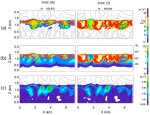Atmospher Sci & Global Chg
Research Highlights
June 2009
Thawing the Mystery of Extra Ice Crystals

Researchers at PNNL have contributed to a greater understanding of how ice crystals form in mixed-phase clouds. Comparing two contributing processes (EVAP_RM and EVAP_DS), these graphics show vertical cross sections of a mixed-phase cloud. In (a), the ice crystals form at different rates and locations in the liquid layer. Ice crystals in EVAP_RM form near the cloud top and ice crystals in EVAP_DS form anywhere in the cloud. Figure (b) shows the relationship between the formation of ice crystals and supersaturation (temperatures) in clouds in the two processes. In (c), there is little difference in ice water content between the two processes. The solid and dotted curves denote the updrafts and downdrafts, or the air vertical movement within the cloud. Enlarge Image.
Results: A team led by Pacific Northwest National Laboratory (PNNL) researchers has presented two processes, or explanations, for how extra ice crystals form in mixed-phase clouds—clouds containing both water and ice—which are prevalent throughout the Arctic. Now, the scientific community has a more accurate understanding of how Arctic clouds affect climate change.
Ice nuclei, a type of aerosol particle in the atmosphere, form the ice crystals in mixed-phase clouds. The team found there were much fewer of these ice nuclei than there were actual ice crystals in the clouds.
The team concluded that other processes were helping form these extra ice crystals. In the first process, droplet evaporation residues condense and then freeze, forming ice crystals near the top of the cloud only. In the second process, droplets shrink during evaporation and then freeze through the inside-out contact freezing mechanism, forming ice crystals any place in the cloud.
The team found that computer simulations that included either of these processes increased the number of ice crystals by 10 to 15 times, similar to amounts found in actual cloud measurements.
The study, published in the Journal of Geophysical Research in February 2009, quickly became one of the journal website's top weekly downloads.
Why it matters: Arctic mixed-phase clouds are complex because they consist of both ice and water. Although these clouds play an important role in Arctic climate change and the energy balance, they have not been understood well and are not well represented in current climate models. Understanding how mixed-phase clouds form and what affects their lifetime and properties will help scientists understand how they affect the overall climate.
Methods: To test ways that aerosols could form ice crystals, researchers created an innovative combined model that more realistically shows the link between ice-forming aerosols and clouds. The team combined an existing dynamic framework with a size-resolved aerosol and cloud microphysics scheme that represents the physics of cloud formation, adding the two new ice-forming processes. The team also incorporated a radar simulator to evaluate how well the model predicted the number and size of ice crystals. In running the combined model, the team used cloud data from a 2004 Atmospheric Radiation Measurement Program field study known as the Mixed-Phase Arctic Cloud Experiment (M-PACE).
What's next: The team is working to gather additional field data and perform further simulations to accurately address aerosol effects on clouds.
Acknowledgments: The research team included Drs. Jiwen Fan, Mikhail Ovtchinnikov, Jennifer Comstock, and Sally McFarlane from PNNL and Dr. Alexander Khain from the Hebrew University of Jerusalem. This research was supported by PNNL's Laboratory Directed Research and Development program as part of the Aerosol Climate Initiative. PNNL is transforming the Nation's ability to predict climate change
Reference: Fan, J., M. Ovtchinnikov, J.M. Comstock, S.A. McFarlane, and A. Khain. 2008. "Ice Formation in Arctic Mixed-Phase Clouds: Insights from a3-D Cloud-Resolving Model with Size-Resolved Aerosol and Cloud Microphysics." Journal of Geophysical Research, 114, D04205, doi:10:1029/2008JD010782.
